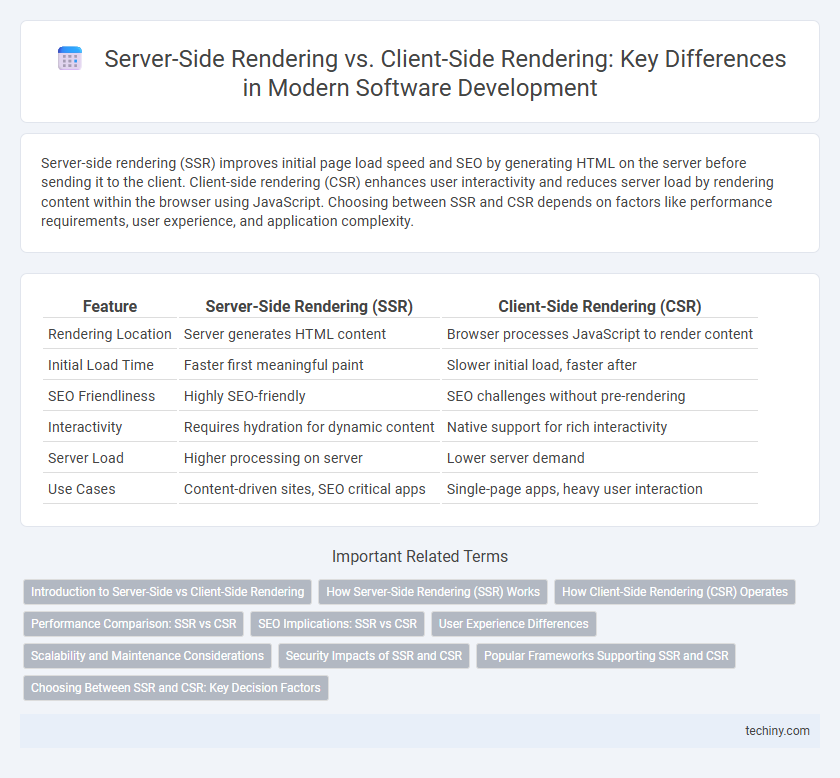Server-side rendering (SSR) improves initial page load speed and SEO by generating HTML on the server before sending it to the client. Client-side rendering (CSR) enhances user interactivity and reduces server load by rendering content within the browser using JavaScript. Choosing between SSR and CSR depends on factors like performance requirements, user experience, and application complexity.
Table of Comparison
| Feature | Server-Side Rendering (SSR) | Client-Side Rendering (CSR) |
|---|---|---|
| Rendering Location | Server generates HTML content | Browser processes JavaScript to render content |
| Initial Load Time | Faster first meaningful paint | Slower initial load, faster after |
| SEO Friendliness | Highly SEO-friendly | SEO challenges without pre-rendering |
| Interactivity | Requires hydration for dynamic content | Native support for rich interactivity |
| Server Load | Higher processing on server | Lower server demand |
| Use Cases | Content-driven sites, SEO critical apps | Single-page apps, heavy user interaction |
Introduction to Server-Side vs Client-Side Rendering
Server-Side Rendering (SSR) generates web page content on the server, delivering fully rendered HTML to the client, which enhances initial load speed and improves SEO performance. In contrast, Client-Side Rendering (CSR) relies on the browser to execute JavaScript, dynamically building the user interface after the initial page load, offering richer interactivity and smoother user experiences. Choosing between SSR and CSR depends on factors like application complexity, performance requirements, and SEO priorities.
How Server-Side Rendering (SSR) Works
Server-Side Rendering (SSR) generates the complete HTML of a web page on the server before sending it to the client, enabling faster initial page loads and improved SEO performance. The server processes data and templates to render the full content, which is then delivered to the browser for immediate display. This approach contrasts with Client-Side Rendering (CSR), where the browser downloads a minimal HTML shell and relies on JavaScript to build the user interface dynamically.
How Client-Side Rendering (CSR) Operates
Client-Side Rendering (CSR) operates by downloading a minimal HTML shell and then dynamically generating content through JavaScript executed in the browser. The browser fetches necessary resources such as HTML, CSS, and JavaScript files, then renders the page content on the client-side, improving interactivity and reducing server load. CSR is commonly used in single-page applications (SPAs) built with frameworks like React, Angular, or Vue.js, where content updates dynamically without full page reloads.
Performance Comparison: SSR vs CSR
Server-Side Rendering (SSR) delivers fully rendered HTML pages from the server, resulting in faster initial load times and improved SEO performance compared to Client-Side Rendering (CSR), which relies on JavaScript execution in the browser to render content. CSR can offer smoother and more interactive user experiences after the initial load but may suffer from slower first contentful paint (FCP) and poor performance on low-powered devices. Optimizing SSR reduces time-to-first-byte (TTFB) and enhances performance consistency across different network conditions, while CSR benefits from reduced server load by offloading rendering tasks to the client.
SEO Implications: SSR vs CSR
Server-side rendering (SSR) significantly enhances SEO by delivering fully rendered HTML content to search engine crawlers, enabling better indexing and faster page load times. In contrast, client-side rendering (CSR) relies on JavaScript to generate content in the browser, which can impede search engines that struggle with or delay executing JavaScript, resulting in poor SEO performance. Leveraging SSR improves visibility on search engines, boosts organic traffic, and provides a more reliable user experience for SEO-critical applications.
User Experience Differences
Server-side rendering (SSR) delivers fully rendered HTML pages from the server, resulting in faster initial load times and improved SEO performance, enhancing user experience by minimizing perceived wait times. Client-side rendering (CSR) relies on the browser to execute JavaScript and render content dynamically, offering smoother interactions and faster subsequent page navigations but potentially slower initial page loads. Balancing SSR and CSR strategies optimizes user engagement by combining quick content delivery with responsive, interactive interfaces.
Scalability and Maintenance Considerations
Server-side rendering (SSR) enhances scalability by reducing client workload and optimizing initial load times, making it suitable for applications with high traffic and SEO requirements. Client-side rendering (CSR) simplifies maintenance through modular, component-based architectures that enable faster iterative updates without full page reloads. Balancing SSR's server resource demands with CSR's client performance considerations is crucial for scalable, maintainable web applications.
Security Impacts of SSR and CSR
Server-Side Rendering (SSR) enhances security by processing content on the server, reducing exposure to client-side vulnerabilities like Cross-Site Scripting (XSS) attacks, as the HTML is fully rendered before reaching the browser. In contrast, Client-Side Rendering (CSR) relies on JavaScript execution in the browser, increasing risks of code injection and data manipulation due to greater client control. Secure implementation of SSR can mitigate sensitive data leakage and improve Content Security Policy (CSP) effectiveness, whereas CSR demands rigorous input validation and secure JavaScript frameworks to safeguard applications.
Popular Frameworks Supporting SSR and CSR
Next.js and Nuxt.js are leading frameworks supporting Server-Side Rendering (SSR), enhancing SEO and initial load performance by rendering pages on the server. React and Angular excel in Client-Side Rendering (CSR), enabling dynamic user interfaces with efficient state management and faster interactions after the initial load. Vue.js supports both SSR and CSR, offering flexibility for developers to choose rendering strategies based on their application requirements.
Choosing Between SSR and CSR: Key Decision Factors
Choosing between Server-Side Rendering (SSR) and Client-Side Rendering (CSR) hinges on factors like SEO requirements, initial load time, and user experience. SSR excels in SEO and faster first contentful paint by rendering pages on the server, while CSR offers dynamic interactivity and reduces server load by rendering content in the browser. Developers must evaluate application complexity, target audience device capabilities, and bandwidth constraints to optimize performance and scalability effectively.
Server-Side Rendering vs Client-Side Rendering Infographic

 techiny.com
techiny.com